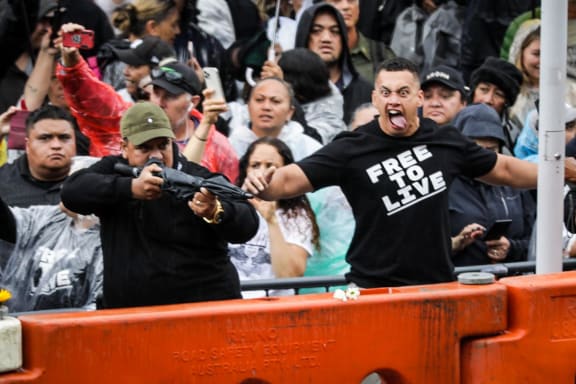Covid skeptics occupied Parliament grounds this week under the banner of ‘freedom’ - and many other things. Did media coverage amplify their fringe views? Should media do more to understand them and what motivates their movement - in spite of their obvious hostility to the media themselves? Mediawatch asks an editor wrestling with those dilemmas.
When ‘Convoy 2022’ was making its way to Wellington last week, some taking part griped that they were being ignored by news media - while some commentators dismissed it as a weak copy of the truckers’ blockade in Canada that didn’t deserve the media attention it did get.
And when it coalesced at Parliament last Tuesday, the PM pointed out the crowd on the lawn outside would be dwarfed by the tens of thousands who got vaccinated just that day.
True enough.
But the same day, BusinessDesk founding editor Pattrick Smellie said critics who belittled the “Clown-voy” missed the point.
“Supporters lined the route in surprising numbers, waving placards in torrential rain. Given more than nine-out-of-10 New Zealanders are vaccinated, this . . . suggests more cohesion among the disparate range of alt-right, conspiracy theorists and sincere, if misinformed, groups that underpin this activity,” he said.
Byron C Clark - who monitors online extremism in New Zealand - reckoned political elements working separately - and without much impact - in the election in 2020 seemed to be working together this time.
Some said the protest was significant beyond the fringe.
And New Zealand Herald columnist Matthew Hooton said the focus on a minority “caught up in conspiracism” obscured more widely-held concerns among reasonable people.
“Wellington political, bureaucratic and media establishments should not kid themselves that only a deranged fringe is feeling enraged by the current situation,” he wrote.
“The protest highlights once more . . . the shattering of a once-united population into multiple discontented factions,” Dominion Post columnist Janet Wilson, a former journalist and spin doctor, declared as it became clear it wasn’t ending anytime soon.
Two thousand people protesting is a splinter, not a fracture - but Bernard Hickey reckoned it was the nastiest protest he’d seen in 35 years - and a sign of things to come.
Smartphones had rewired the “neural network” of our politics, he argued - and social media algorithms amplifying misinformation and extremism are now “an existential threat . . to our national security and welfare,” he said in his podcast / blog The Kākā
Oxygen of publicity?

Photo: RNZ / Nate McKinnon
After protesters were trespassed but stood their ground on Wednesday, Stuff began to livestream the stand-off.
Civil servants rubbernecking digitally from the safety of their workstations reportedly strained the servers of government departments - and TVNZ and RNZ later also ran their own livestreams too.
“There's public interest of course -- but providing an avenue for unfiltered misinformation from the protesters and speakers (albeit only semi-audible) is not ideal,” Newsroom.co.nz journalist Sam Sachdeva tweeted.
Predictably perhaps, simply saying that on social media attracted hostile replies accusing him of filtering the truth, working for the government and the forces of socialism - and so on.
Did coverage amplify the protestors’ fringe concerns and make their movement look more powerful than it really is?
“We have a duty to report a relatively big protest on the grounds of parliament that is disrupting our city,” the editor of Wellington’s daily paper The Dominion Post Anna Fifield told Mediawatch.
“We are careful in the way we crop photos, and a lot of that live stream has been focused on the Police and what they are doing to try to maintain security. I hope we got that balance right this week,” she said.
Take me to you leader . . .

Anna Fifield Photo: Supplied
Police said the lack of recognised leaders made it impossible to negotiate with the crowd - and media faced the same problem.
Spokespeople and political supporters are usually only too happy to comment on behalf of a cause for which people are prepared to wave placards in big numbers.
Not this time.
Those in the highly-vaxxed and overwhelmingly Covid-compliant capital were perplexed by the anger they saw via news media - and the delusions protesters had evidently embraced.
But the motivations, mood and methods of the Convoy crowd could better be glimpsed via the messaging apps, social platforms, alt-news sources and live-streams they use.
Anti-extremist researchers and groups revealed known extremists taking part by monitoring social media. Parliamentary building Bowen House was closed when Paparoa drew attention to one extremist posting content from inside.
Three days into the protest the role of US-based online outlet Counterspin - which was both broadcasting and influencing events - became a focus for the mainstream media.
Prime movers such as Kelvyn Alp turned their own encounters with reporters into more content for the non-stop Counterspin stream - and TVNZ’s Cushla Norman confronted him - and also dug into the archives for his unpleasant backstory - on Friday’s 1 News.
This weekend Stuff’s Charlie Mitchell boiled down hours of Counterspin’s live output for a vivid vignette of what its subscribers and supporters were viewing.
On Newsroom.co.nz Marc Daalder scraped posts on encrypted messaging app Telegram and other social media to show how the convoy went from “a targeted protest of vaccine mandates to a vehicle for fringe and even violent extremist ideologies.”
“What organisers hoped would be a mass movement shutting down the nation's capital until vaccine mandates were removed has devolved into a few hundred radical protesters scrapping with police, death threats against politicians which is keeping any MPs from turning out to speak with the aggrieved, and the hijacking of the event by a Trump-aligned alternative media outlet” - Marc Daalder.
Shooting the messengers

Photo: RNZ / Nate McKinnon
Another headache for media was that many in the crowd saw them as the enemy, alongside the government.
“I spoke to a woman today who travelled from Christchurch, who asked me why I wasn’t covering the Nuremberg trials 2.0 as casually as if she was asking if I’d like a cup of tea,” recalled TVNZ’s Kristin Hall, who was moved off a Parliament building balcony because her presence there incited the crowd.
And the following day it went up a notch.
A woman carrying sign about peace and love told her she would be executed.
“Getting pretty sick of this sort of nonsense,” Hall tweeted on Tuesday.
She wasn't the only one.
“Journalists need to be safe to keep New Zealand’s democracy safe from the types of attacks we’ve seen elsewhere in the world,” said Stuff chief editor Mark Stevens, lamenting the abuse of his reporters this week.
But possibly the most disturbing incident happened last week at Stuff’s Taranaki Daily News.
An angry mob gathered in the foyer and some surged though secure doors to try to confront the staff in the New Plymouth HQ.
Counterspin aired footage of ring leader Brett Power declaring they would be back to hold the editor “accountable for crimes”
That crowd in New Plymouth included two local councilors who also joined the convoy to Wellington -- where Power was arrested on Wednesday, screaming about “media guilt” as he was led away.
But The Taranaki Daily News only mentioned this incursion in passing way down a story about the New Plymouth protest.
“I don't think that we deliberately downplayed this incident. It's a really factual account of what happened. No journalist or staff ever encountered any of these protesters. . . were in the lobby in that a relatively short period of time,” Fifield told Mediawatch.
“But my background in the US has taught me not to be complacent about these kinds of threats and the power of the mob to wind each other up and to do this kind of thing,” said Fifield.
“The bigger picture is . . .people trying to go to school or go to work around Parliament grounds and Police who are confronting these people,” she said.
“I was surprised to some extent that this was happening in New Zealand, but also not surprised at all because we have seen the steady move towards going from hateful kind of speech and trying to intimidate journalists to people taking action,” she said.
“We do take it really seriously,” she said.
“I've been down to Parliament several times this week to check on my team and get a sense of what's going on. It's a very small vocal minority but it's incumbent on us to try to understand what is motivating the small group of people to take such action.”
“These people will not be persuaded or dissuaded by the facts or by the government response - and they will continue to act in this way. As an editor, I'm worried about what that means for journalists - and from a kind of nationwide point of view. But I doubt very much doubt that they are going to persuade the wider public of the merits of their arguments, whatever they are,” she said.

